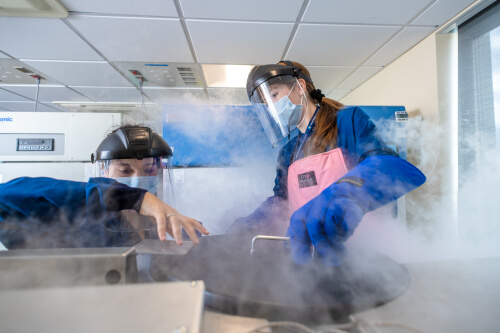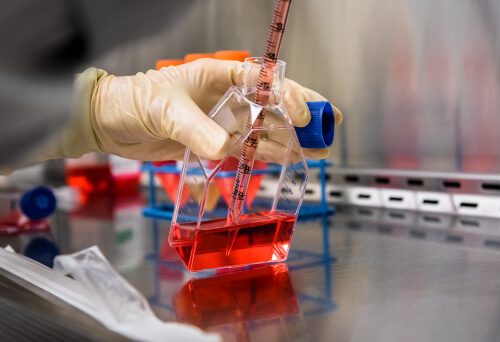A recent phase 1 trial of a form of cellular gene therapy for sickle cell disease (SCD) conducted at Dana-Farber/Boston Children’s Hospital showed promise that led to an ongoing nationwide phase 2 initiative. Among the authors of the paper describing the results were six unsung heroes whose behind-the-scenes efforts made such a trial possible.
Those unsung heroes work in the Connell and O’Reilly Families Cell Manipulation Core Facility (CMCF) at Dana-Farber. The CMCF team plays a central role in advancing cell therapies. They move projects from idea to patient-ready therapy and — as in the case of the sickle cell gene therapy trial — work with both academic and industry investigators to bring their experimental cell therapies into the clinic.
“We see the entire scope of the cell therapy field from a biological, clinical, manufacturing and technology transfer perspective,” says Jerome Ritz, MD, executive medical director of the CMCF. “We can help.”

The CMCF, formally established in 1996, is among the oldest and largest of academic cell therapy manufacturing facilities, with a physical footprint of 34,000 square feet and over 70 staff. The team manages upwards of 60 clinical trials, performs complex manufacturing for over twenty U.S. Food and Drug Administration (FDA) investigational new drug (IND) applications, and dispenses over thirteen hundred unique products each year.
The facility’s manufacturing facilities are split in two, with one area focused on experimental cell manufacturing, including genetic manipulation, and the other on more standard and commercially sponsored cell therapies.
With so much experience, the CMCF is also spearheading efforts to help standardize cell therapy across the medical industry so that novel cellular products can reach more patients faster and at the highest quality.
Cell pharmacy, bespoke therapy, and everything in between
One capability that sets this team apart is its ability to support a range of therapy types and a wide variety of collaborators.
To support that phase 1 clinical trial of gene therapy for SCD, for example, the team worked closely with laboratory and clinical investigators, such as David A. Williams, MD, and Erica B. Esrick, MD, at Dana-Farber/Boston Children’s Cancer and Blood Disorders Center, to validate the manufacturing procedure at clinical scale and then manufacture genetically modified stem cells for each patient enrolled on the clinical trial.
“We can help nail down the final details when it comes to manufacturing and clinical implementation,” says Sarah Nikiforow, MD, PhD, medical director at the CMCF.
Building on results from the phase 1 trial, a phase 2 trial is already enrolling and treating patients in multiple locations in the United States. The clinical trial is jointly funded by the National Institutes of Health (NIH) and California Institute for Regenerative Medicine (CIRM) and the CMCF is manufacturing genetically modified stem cells to support the phase 2 trial for patients enrolled at five trial sites across the nation (outside of California).
If successful, CMCF would transfer the manufacturing process to additional manufacturing sites that would be needed to support future commercialization of this approach and treatment of larger numbers of patients. This highlights another area of the team’s expertise: scaling processes and distribution models as demand grows.
The CMCF also acts as what Nikiforow calls a “cell pharmacy,” meaning it manages cell therapies that are manufactured at an outside, often a commercial, facility. These cell therapies can be experimental or FDA-approved. The CMCF supports cell pharmacy for approximately 35 trials and provides support for all the FDA-approved CAR T-cell therapies (currently six) and stem cell-based gene therapies (two).
“The types of cells that go in and out of CMCF are highly variable and for a multitude of patients and disease indications,” says Nikiforow. “Every bag of cells is part of our exciting clinical mission, even if doesn’t involve complicated manufacturing on our end.”

Enabling innovative cell therapy
In contrast to GMP manufacturing facilities located in biotech or pharmaceutical companies, the CMCF is an academic facility designed to support a variety of investigators who are each developing unique and innovative approaches that need to be tested in early phase clinical trials. For example, CMCF works with Dana-Farber physician-scientist Rizwan Romee, MD, and clinical collaborators Roman Shapiro, MD, in the Division of Stem Cell Transplantation and Cell Therapies, and Glenn J. Hanna, MD, in Head and Neck Cancer, to manufacture cytokine-induced memory-like NK cells for patients with AML and head and neck cancer. CMCF also manufactures regulatory T cells for patients with chronic graft versus host disease (GVHD) after stem cell transplant.
For a protocol that attempts to improve outcomes for high-risk patients undergoing allogeneic stem cell transplant, CMCF is working with physician-scientist John Koreth, MBBS, DPhil, to provide “sculpted” stem cell grafts. The grafts include specified numbers of effector T cells, regulatory T cells and hematopoietic stem cells that can be infused without the need for post-transplant immunosuppression.
“CMCF is a core capability at Dana-Farber, especially for immune cell therapies,” says Koreth. “It is an enabler for us in transplant, in other immune therapy programs, and increasingly in solid tumor oncology.”
In recent years, there have been so many innovative cell therapy projects that in 2019 the CMCF created a process development group. The group works with investigators across the Harvard community to help them develop reproducible and safe manufacturing processes for their small-scale first-in-human investigations.
One current project is a collaboration with Dana-Farber scientist Baochun Zhang, MD, PhD, in the Division of Hematologic Neoplasia, to manufacture CD4+ cytotoxic lymphocytes (CD4 CTL) for treatment of B cell lymphoma and chronic lymphocytic leukemia. This therapeutic approach is based on work in Zhang’s lab demonstrating that expression of LMP1, an Epstein Barr Virus (EBV)-derived protein in B cell tumors, makes them highly immunogenic and that tumor rejection is mediated by CD4 CTL. Funded by a Dana-Farber Accelerator Award, the team is developing and validating methods to manufacture CD4 CTL for a planned FDA IND submission early in 2024.
Expertise is best when shared
New ideas for unique cell therapies are coming in fast and furious and for a wide range of cancers and diseases. As a result, even the largest manufacturing facilities are struggling to support the growing number of unique logistical and clinical workflows.
“The field is grappling with how to standardize processes not only for sustainability and safety, but also for accessibility, so that cell therapy can be more widely available,” says Olive Sturtevant, MHP, senior administrative officer of the CMCF.
For this reason, the experts at the CMCF are collaborating widely – with the FDA, professional societies, corporations, and clinical colleagues. They are teaming up to create new standards and to scale and replicate processes without sacrificing quality.
“We have embedded ourselves in the conversations happening upstream and downstream of us,” says Sturtevant. “Partnering is how we share our experiences and learn from others.”
“We expect rapid and continued growth in the field of cellular therapy,” says Ritz. “CMCF is well positioned to contribute at many levels and to provide a variety of novel cellular products for the benefit of our patients.”
